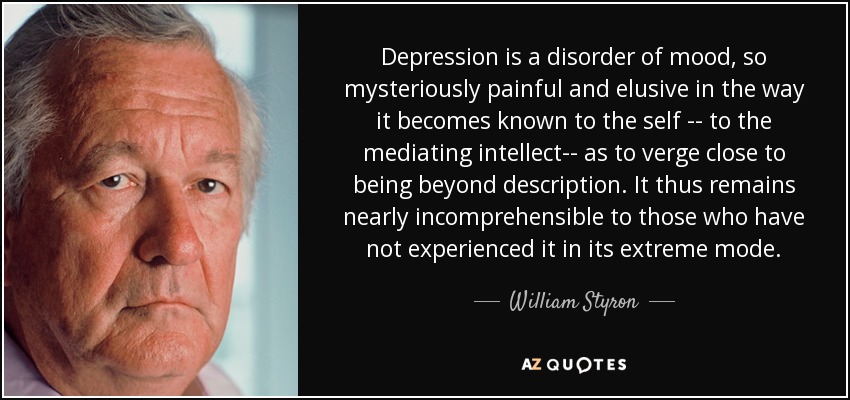
In a piercing letter to his brother, Vincent van Gogh captured the mental anguish of depression in a devastatingly perfect visceral metaphor: “One feels as if one were lying bound hand and foot at the bottom of a deep dark well, utterly helpless.”Anyone who has suffered from this debilitating disease knows that the water in that well is qualitatively, biochemically different from the water in the puddle of mere sadness. And yet, even as scientists are exploring the evolutionary origins of depression and the role REM sleep may play in it, understanding and articulating the experience of the disease remains a point of continual frustration for those afflicted and a point of continual perplexity for those fortunate never to have plummeted to the bottom of the well.
No one has captured this perennial plague of the human spirit with greater vividness and acuity than William Styron (June 11, 1925–November 1, 2006) in Darkness Visible (public library) — his trenchant 1990 memoir of depression.
Styron, who first descended into clinical depression at the age of sixty and describes himself as “one who has suffered from the malady in extremis yet returned to tell the tale,” considers the cultural baggage of this “veritable howling tempest in the brain,” propelled by “the intermingled factors of abnormal chemistry, behavior and genetics”:
When I was first aware that I had been laid low by the disease, I felt a need, among other things, to register a strong protest against the word “depression.” Depression, most people know, used to be termed “melancholia,” a word which appears in English as early as the year 1303 and crops up more than once in Chaucer, who in his usage seemed to be aware of its pathological nuances. “Melancholia” would still appear to be a far more apt and evocative word for the blacker forms of the disorder, but it was usurped by a noun with a bland tonality and lacking any magisterial presence, used indifferently to describe an economic decline or a rut in the ground, a true wimp of a word for such a major illness. It may be that the scientist generally held responsible for its currency in modern times, a Johns Hopkins Medical School faculty member justly venerated — the Swiss-born psychiatrist Adolf Meyer — had a tin ear for the finer rhythms of English and therefore was unaware of the semantic damage he had inflicted by offering “depression” as a descriptive noun for such a dreadful and raging disease. Nonetheless, for over seventy-five years the word has slithered innocuously through the language like a slug, leaving little trace of its intrinsic malevolence and preventing, by its very insipidity, a general awareness of the horrible intensity of the disease when out of control.
One of the most striking paradoxes of the disease is that despite its devastating prevalence — depression is the most common form of disability in the world today — its symptoms are so imperceptible from the outside that it is extremely difficult to tell who is suffering and who is not. And yet what goes on inside is acute and unmistakable. Styron captures it with penetrating precision:
The gray drizzle of horror induced by depression takes on the quality of physical pain. But it is not an immediately identifiable pain, like that of a broken limb. It may be more accurate to say that despair, owing to some evil trick played upon the sick brain by the inhabiting psyche, comes to resemble the diabolical discomfort of being imprisoned in a fiercely overheated room. And because no breeze stirs this caldron, because there is no escape from this smothering confinement, it is entirely natural that the victim begins to think ceaselessly of oblivion.
From visual educators at TED Ed — who have previously explored the history of melancholy — comes this animated primer on what depression really is and how to best be there for those afflicted:
For an elevating counterpoint, see Tchaikovsky — a lifelong sufferer of the disease — on depression and finding beauty amid the wreckage of the soul.



No comments:
Post a Comment